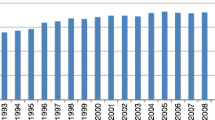Abstract
This paper examines the determinants of export performance of firms in the Greek manufacturing industry, using cross-sectional data from 1652 firms in 1999 and a Tobit regression model. The study finds that firms that have larger size, lower unit labor cost and low capital to labor ratio have a higher propensity to export, confirming the fact that in Greece, which has the second lowest capital to labor ratio among the EU-15 members, export activities are concentrated among firms with low capital intensity, exactly as the theory of competitive advantage would predict.
Similar content being viewed by others
References
Abbas, A. and Swiercz, P.M. (1991), “Firm size and export behavior: lessons from the Midwest”Journal of Small Business Management, April, pp. 71–78.
Auquier, A. (1980), “Sizes of firms, exporting behaviour, and the structure of the French industry”The Journal of Industrial Economics,29, pp. 203–218.
Anderton, B. (1999a), “UK Trade Performance and the Role of Product Quality, Innovation and Hysteresis: Some Preliminary Results”Scottish Journal of Political Economy,46, pp. 570–595.
Anderton, B. (1999b), “Innovation, Product Quality, Variety and Trade Performance: an Empirical Analysis of Germany and the UK”Oxford Economic Papers 51, pp. 152–167.
Aw, Bee Yan, Sukkyun Chung and Mark J. Roberts (1999), “Productivity and Turnover in the Export Market: Micro Evidence from Taiwan and South Korea”, mimeo.
Basile, R. (2001), “Export Behaviour of Italian Manufacturing Firms Over the Nineties: The Role of Innovation”Research Policy,30, pp. 1185–1201.
Bonaccorsi, A. (1992), “On the relationship between firm size and export intensity”Journal of International Business Studies, pp. 605–635.
Caves, R. (1986). “Exporting behavior and market structure: evidence from the United State”, In Jong, H., and Sheperd, W.G. (Eds), Mainstreams in Industrial Organizations, Martinus Nijhof, Dordecht, pp. 189–210.
Crone, M. and Roper S. (2001). “Local Learning and the Supply-Chain: Knowledge Transfers from Multi-national Plants”, Regional Studies.
Das, Sanghamitra, Mark Roberts and James Tybout (2000), “Micro Foundations of Export Dynamics”, mimeo.
Davis, D., Weinstein, D., Bradford, S. and Shimpo, K. (1997), “Using international and Japanese regional data to determine when factor abundance theory of trade works”American Economic Review,87, pp. 421–446.
Dritsaki, M., Dritsaki, C. and Adamopoulos, A. (2004), “A causal relationship between Trade, Foreign Direct Investment and Economic Growth in Greece”American Journal of Applied Sciences,1 (3), pp. 230–235.
Feenstra, R.C. and Hanson, G. (2000), “Aggregation bias in the factor content of trade: evidence from US manufacturing”American Economic Review,90, pp. 155–160.
Glesjer, H., Jacquemin, A. and Petit, J. (1980), “Exports in an imperfect competition framework: an analysis of 1446 exporters”Quarterly Journal of Economics,94, pp. 507–524.
Greenhalgh, C., Taylor, P., Wilson, R. (1994), “Innovation and Export Volumes and Prices: a Disaggregated Study”Oxford Economic Papers,46, pp. 102–134.
Gumede, V. (2004), “Export Propensities and Intensities of Small and Medium Manufacturing Enterprises in South Africa”Small Business Economics,22, pp. 379–389.
Hirch, S. and Bijaoui, I. (1985), “R&D intensity and export performance: a micro view”Weltwirtschaftches Archiv,121, pp. 138–251.
Kumar, N. and Siddharthan, N.S. (1994), “Technology, firm size and export behaviour in developing countries: the case of Indian enterprise”J. Dev. Studies,32 (2), pp. 288–309.
Maskus, K. (1985), “A test of Heckscher-Ohlin-Vanek theorem: the Leontief commonplace”Journal of International Economics,19, pp. 201–212.
Mason, C. and Wagner, K. (1994), “Innovation and the Skill Mix: Chemicals and Engineering in Britain and Germany”National Institute Economic Review, May, pp. 61–72.
Nassimbeni, G. (2001), “Technology, innovation capacity, and the export attitude of small manufacturing firms: a logit/tobit model”Research Policy,300, pp. 245–262
OECD (2001), Science, Technology and Industry Scoreboard 2001, Towards a Knowledge-based Economy.
Oguebi, A.O. and Longfellow, T.A. (1994), “Perceptions of US manufacturing SMEs concerning exporting: a comparison based on export experience”Journal of Small Business, pp. 37–47.
Ong, C.H. and Pearson, A.W. (1982), “The impact of technical characteristics on export activity: a study of small and medium-sized UK electronic firms”R&D Management,12, pp. 189–196.
Ramazani, R. and Maskus, K. (1993), “A test of the factor endowments model of trade in a rapidly industrializing country: the case of Korea”The Review of Economics and Statistics,75, pp. 568–572.
Rapp, W. (1976), “Firm size and Japan’s export structure” In: Patrick, H. (Ed.). Japanese Industrialization and its Social Consequences,The University of California Press, Berkeley, pp. 201–248.
Roper, S. and Love, J.H. (2002), “Innovation and export performance: evidence from the UK and German manufacturing plants”Research Policy,31, pp. 1087–1102.
Sterlacchini, A. (1999), “Do Innovative Activities Matter to Small Firms in Non-R&D-Intensive Industries? An Application to Export Performance”Research Policy,28, pp. 819–832.
Styles, C. and Ambler, T. (1994), “Successful export practice: the UK experience”International Marketing Review,11 (6), pp. 23–47.
Ursic, M.L. and Czinkota, M.R. (1984), “An experience curve explanation of export expansion”Journal of Business Research,12, pp. 159–168.
Vermeulen, P. (2004), “Factor content, size, and export propensity at the firm level”Economics Letters,82, 249–252.
Vespagen, B. and Wakelin, K. (1997), “Trade and Technology from a Schumpeterian Perspective”International Review Appl. Econ. 11 (2), pp. 181–194.
Wagner, J. (1995), “Exports, Firm Size and Firm Dynamics”Small Business Economics,7 (1), pp. 29–39.
Wagner J. (2001), “A Note on the Firm Size-Export Relationship”Small Business Economics,17 (4), pp. 229–237.
Wakelin, K. (1998), “Innovation and Export Behavior at the Firm Level”Research Policy,26, pp. 829–841.
Westhead, P. (1995), “Exporting and Non-exporting small firms in Great Britain-a matched pair comparison”International Journal of Entrepreneurial Behaviour and Research,1 (2), pp. 6–36.
Willmore, L. (1992), “Transnationals and foreign trade: Evidence from Brazil”J. Dev. Studies,28 (2), pp. 314–335.
Author information
Authors and Affiliations
Rights and permissions
About this article
Cite this article
Papadogonas, T., Voulgaris, F. & Agiomirgianakis, G. Determinants of export behavior in the Greek manufacturing sector. Oper Res Int J 7, 121–135 (2007). https://doi.org/10.1007/BF02941189
Issue Date:
DOI: https://doi.org/10.1007/BF02941189




